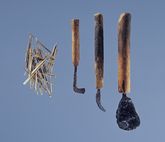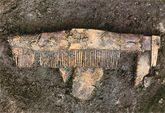The Barber Surgeon
There are no sources or law texts that mention actual medical care on board Viking ships. The closest we can get to a picture of Viking ill-health and hygiene is in the archaeological finds and the observations of the travelling Arab author, Ibn Fadlan.
Treatment of wounds and diseases
Finds of Iron Age surgical instruments in bogs, placed there as war-booty sacrifices, show the existence at that time of so-called barber-surgeons responsible for the medical treatment of war wounds.
The oldest artefacts from the site in Illerup Ådal date back to around AD 200. The site yielded surgical knives for cleaning wounds, knives to cut away dead tissue, bone saws as well as pins and thorns, which were used for holding together the wound so that it could heal.
In Nydam bog, several pairs of tweezers were found, which were used in connection with personal hygiene, such as in the removal of unwanted hair, but others were for holding the edges of a wound together during treatment.
It is likely that there were barber-surgeons in the Viking Age and that they numbered among the crew on the Viking warships.
Illness at sea
Apart from wounds and injuries from battle, we do not know what illnesses that could occur on board a Viking ship. But the medical log from the ship Freya’s voyage to the Danish West Indies in the 1700s tells us a little about illnesses during long sea voyages:
The ship had a crew of 322, mainly young men. In the period from 1795–97 they suffered from dysentery, diarrhoea, vomiting of blood, gall-fever, serious wounds and injuries, scurvy and infectious venereal diseases such as syphilis and gonorrhoea.
Although the ship’s doctor could treat venereal disease with mercury, it was difficult to stop these diseases from spreading quickly among the crew, because they lived so closely together on board ship.
Viking hygiene
Ibn Fadlan also mentions Viking hygiene in his narrative, describing them as the filthiest of Allah’s creatures. “They never wash themselves after they have defecated, urinated or had sexual intercourse, and neither do they wash their hands after they have eaten”.
When they did wash, it took place, according to Ibn Fadlan, in the same water:
Quote: “Every day, early in the morning, one of the slave girls brings in a large dish of water and gives it to her master, who washes his hands, face and hair in it. Then he combs his hair over the dish with a comb, blows his nose and spits in it. No dirt is removed from the water. When the first has finished, the slave girl carries it to the next, who does the same, after which she carries it from one to another until it has been all the way round. Every one of them blows his nose and spits in it and washes his face and hair in it.”
Seen in relation to the Muslims, who were obliged to wash the face, hands and feet before each of the day’s five prayers, Viking washing habits seem most unclean. Conversely, the people of the British Isles found the Vikings to be vain, and bemoaned the fact that they also attracted the attention of the local women. What is seen depends on the eye that sees ..!
But several archaeological finds do suggest that the Vikings thought about hygiene and were interested in how they looked.
In Kaupang in Norway, a bowl has been found which it is thought Vikings used to wash their hands before meals, because the runes engraved on the dish say: ‘I Muntlauki’ (hand-washing bowl).
It is also quite normal to find combs of various sizes, pairs of tweezers of iron or bronze, and ear picks (aural scoops) among items in graves. In the Treasure of Terslev from the 900s, a toilette requisite in silver was found that was probably used to clean the fingernails. Grooves on teeth found on skeletons also show that it was customary to use toothpicks. A Bronze Age razor has also been found, and even though nothing is known of similar finds from the Viking Age, there are several pictures, statuettes and carved wooden figures which show the Viking with well-groomed hair and a well-trimmed beard.
By: Louise Kæmpe Henriksen
Did you know
That the Vikings isolated their sick?
If a warrior became sick, they put up a tnet and left him there. He would only receive bread and water and nobody was allowed inside the tent.
When he recovered he could join the group again. If he died, they would burn and burrie him.

